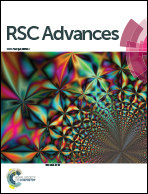Quantification of hot carrier thermalization in PbS colloidal quantum dots by power and temperature dependent photoluminescence spectroscopy†
Abstract
PbS QDs are studied as attractive candidates to be applied as hot carrier solar cell absorbers. The thermalization properties of PbS QDs are investigated with power and temperature dependent continuous wave photoluminescence (CWPL). Non-equilibrium hot carrier populations are generated by high energy laser excitation, the thermalization coefficient Q is estimated from the incident power dependent carrier temperature. A non-equilibrium hot carrier population 200 K above the lattice temperature is detected at mild illumination intensity. A higher energy carrier population and an increasing Q value are observed with rising lattice temperatures. State filling effects are proposed as a possible cause of the generation of the non-equilibrium hot carrier population and an enhanced electron–phonon coupling strength is suggested to account for the faster carrier cooling rate observed in closely packed Langmuir–Blodgett monolayer films. A thermalization coefficient, Q, as low as 6.55 W K−1 cm−2 was found for the drop cast sample and suggests that PbS QDs are good candidates for practical hot carrier absorbers.


 Please wait while we load your content...
Please wait while we load your content...